Hiking to Munsubong Peak at Bukhansan
Last month, I had a bit of a spontaneous hiking adventure that turned out to be one of my most memorable experiences in Korea. It all started with a new pair of hiking shoes I had picked up during a visit to Emart after missing the EPS Bangla picnic event. I was out with Mamun Bhai, Reza Bhai, and his wife, exploring Majang Lake and nearby streams when I found a pair of hiking boots that immediately caught my attention. Although I didn’t plan to buy anything, I ended up purchasing them on a whim—something that would lead me to an unforgettable trip to Munsubong Peak at Bukhansan Mountain

The Unexpected Start to the Adventure
About a month after buying the boots, I finally put them to use on an impromptu hiking trip to Munsubong Peak in Bukhansan National Park. That Sunday was my off day, and to my surprise, I woke up much earlier than usual. I couldn’t figure out why, but as soon as I opened my eyes, I felt like doing something different. Without much thought, I slipped on my new hiking boots and began rolling around on the bed, debating whether I should go on a hike or stay home. For almost an hour, I couldn’t decide—packing and unpacking my bag, questioning if the weather would be ideal.
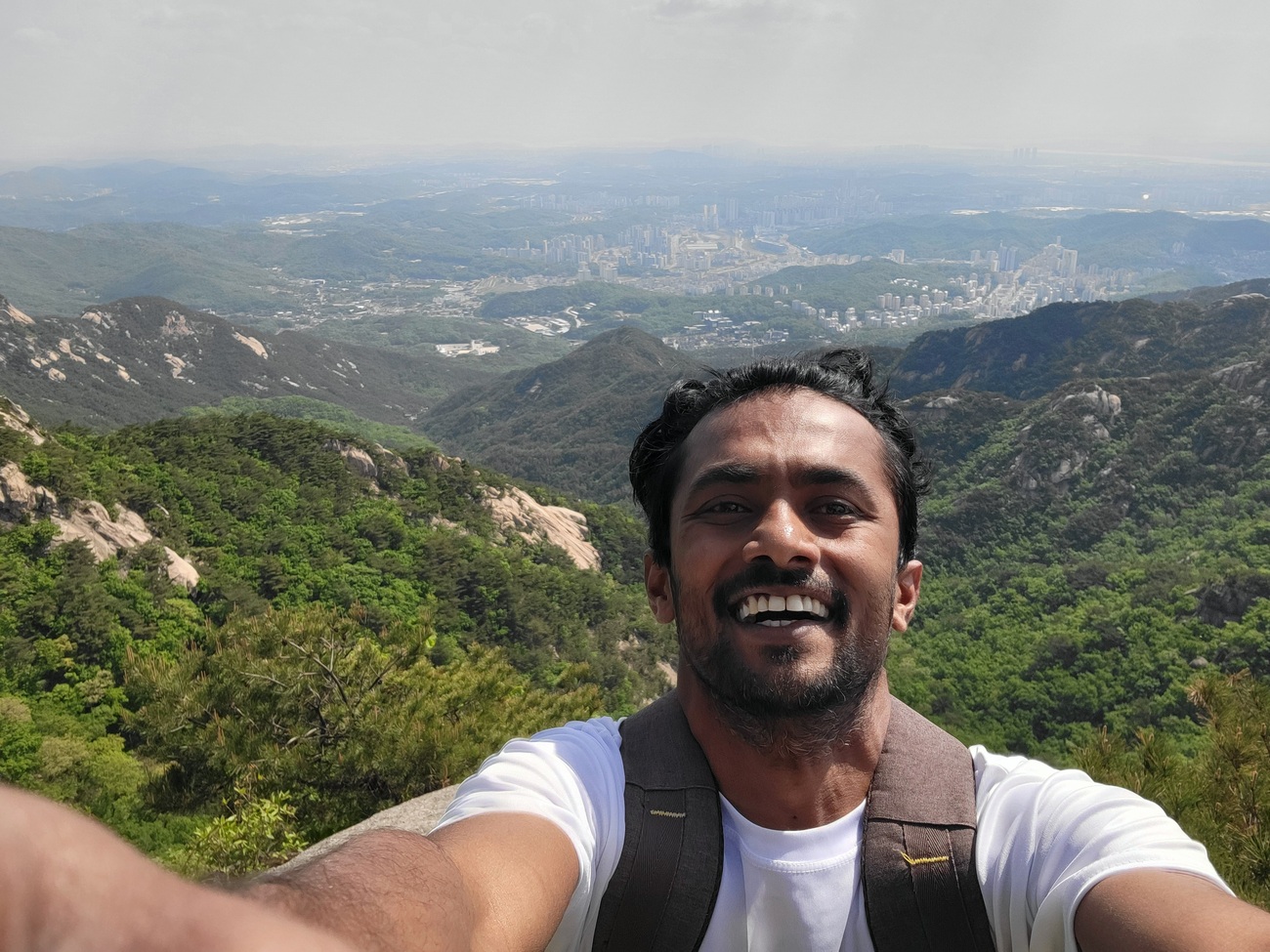
Korean weather can be unpredictable. One day it’s sunny, and the next it could be freezing or raining. But that day, something inside me was pushing me to get outdoors. While scrolling through the maps on my phone, I stumbled upon Munsubong Peak. I thought, “It’s been a while since I’ve done serious hiking. Why not give it a shot?” Without overthinking it any further, I packed my bag and decided that this would be the perfect opportunity to explore a new mountain in Seoul.
A Quick Call to a Hiking Companion
That’s when I messaged my friend Chanchal to see if he wanted to join me. To my surprise, he called back immediately and said he was ready to go. Within minutes, our hiking plans were set, and my new boots were about to face their first real test. It was exciting because, although I’ve hiked Bukhansan National Park several times, Munsubong Peak was a new destination for me.
Getting Ready for the Hike
I wasn’t fully prepared for a long hike that day since I hadn’t had breakfast, and the sun was already heating up the day. After a bit of rushing, I gathered the essentials—water, some snacks, and a light lunch—before meeting Chanchal at Gupabal Station. For those unfamiliar, Gupabal Station is one of the most popular starting points for hikers heading to Bukhansan Mountain, thanks to its easy connections to different trailheads.
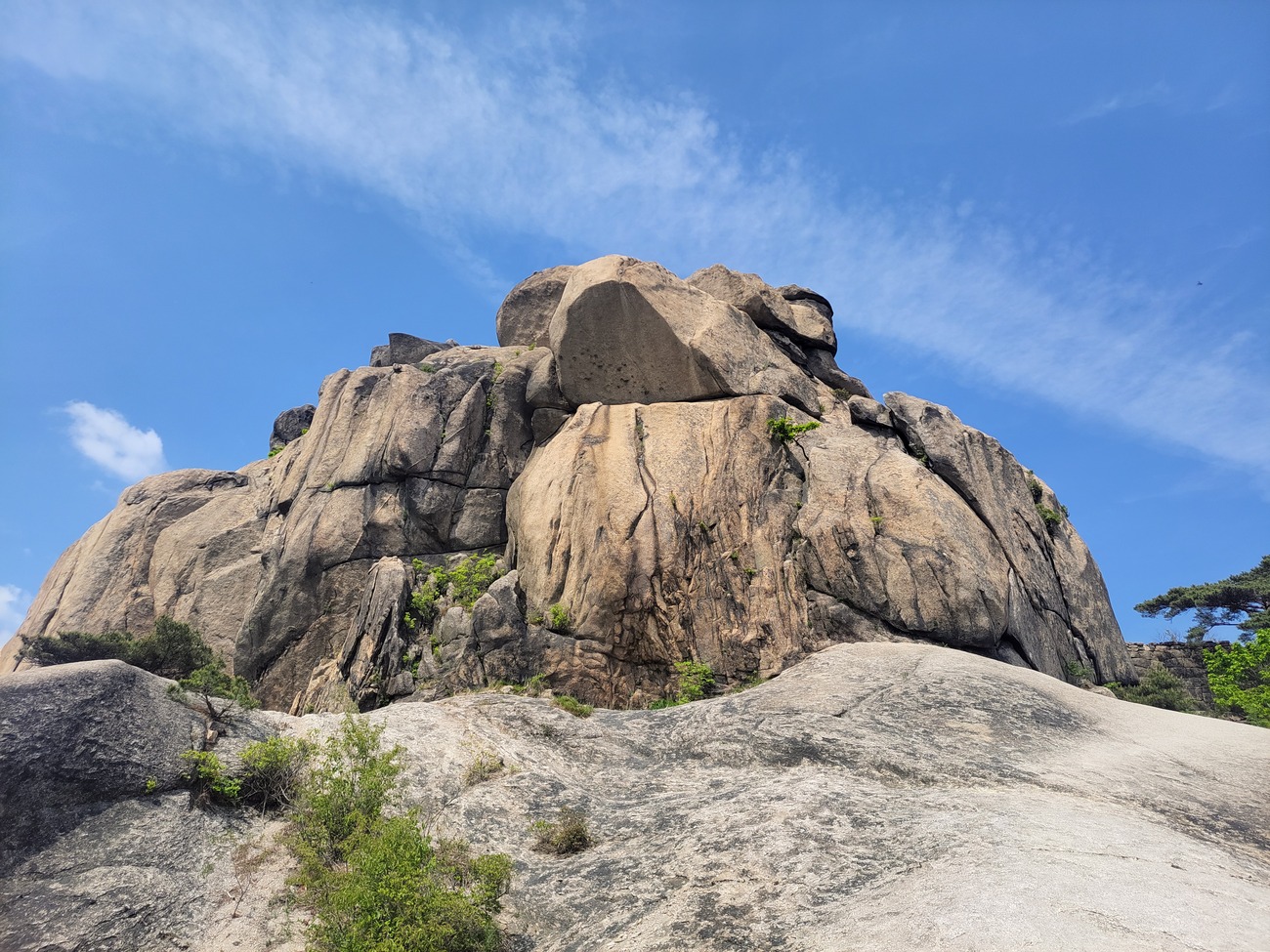
We grabbed some extra food and supplies at a nearby convenience store before hopping on the 7842 bus, which took us directly to the Bukhansan National Park entrance. From there, our real adventure began. The trail to Munsubong starts at Daeseongmun Gate (대성문), a well-known entry point for many of Bukhansan’s hiking trails. As we entered the park, I couldn’t help but feel a surge of excitement. The air was fresh, and the greenery around us made it clear that this hike would be worth the effort.
The Trail to Munsubong Peak
We began our journey on the trail leading from Daeseongmun to Daenammun Gate. The path was a mix of rocky terrain and dense forest, typical of the Bukhansan Mountain experience. The sound of leaves rustling and birds chirping added to the peaceful vibe of the trail. The initial 40 minutes of hiking were relatively easy, but I quickly realized how much I regretted skipping breakfast. The heat of the day was catching up with me, and I had to stop a few times to catch my breath.
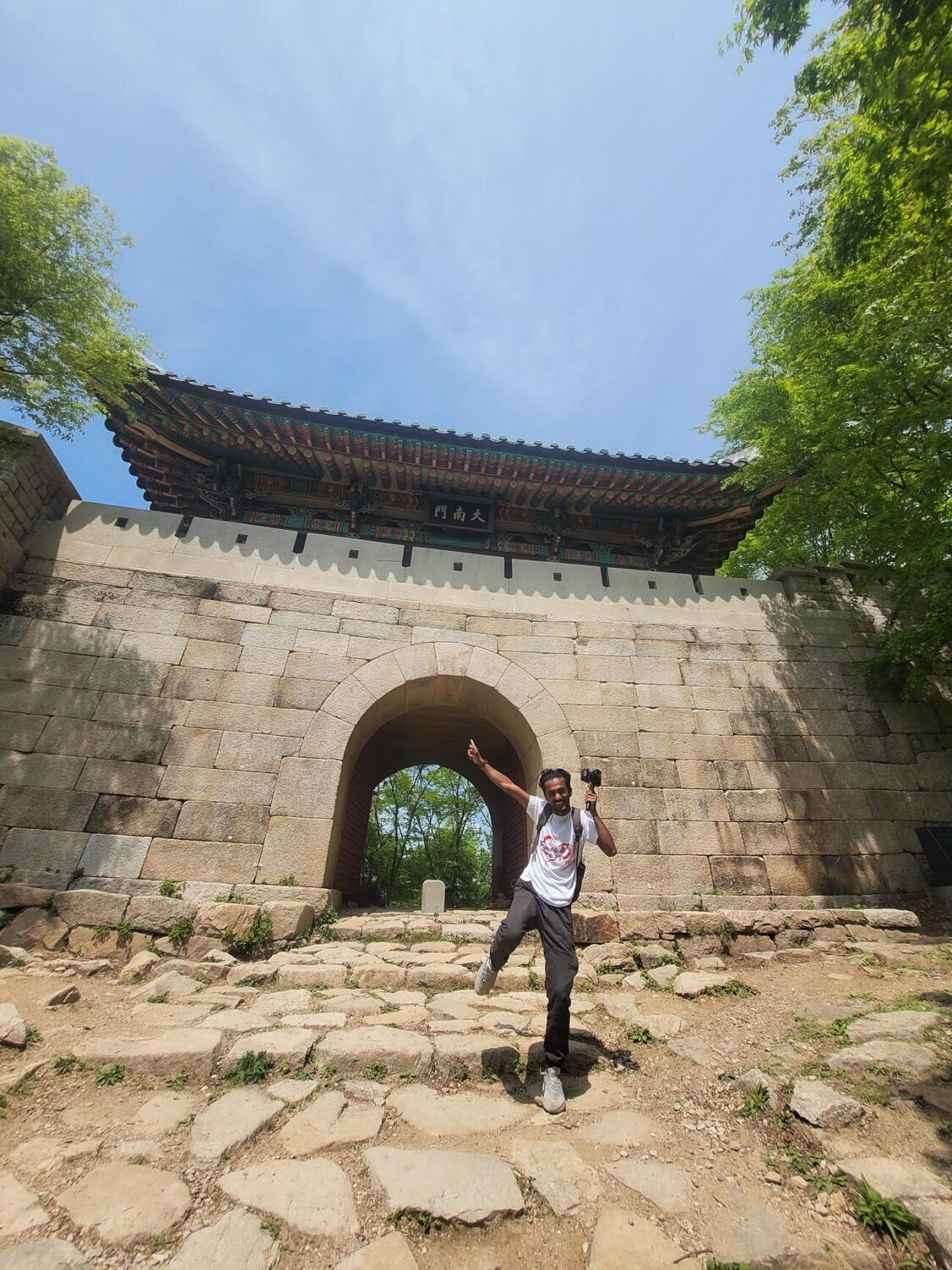
After reaching Daenammun, we took a left turn to follow the trail toward Munsubong Peak. The trail became more challenging, with steeper sections and uneven surfaces. Although it wasn’t raining, the rocks were still slippery from a previous drizzle, so we had to be extra cautious. Along the way, we passed a few small streams, but they had mostly dried up, leaving only small pools of water. Despite the occasional fatigue, we pushed forward, knowing that the view from the peak would be worth every step.
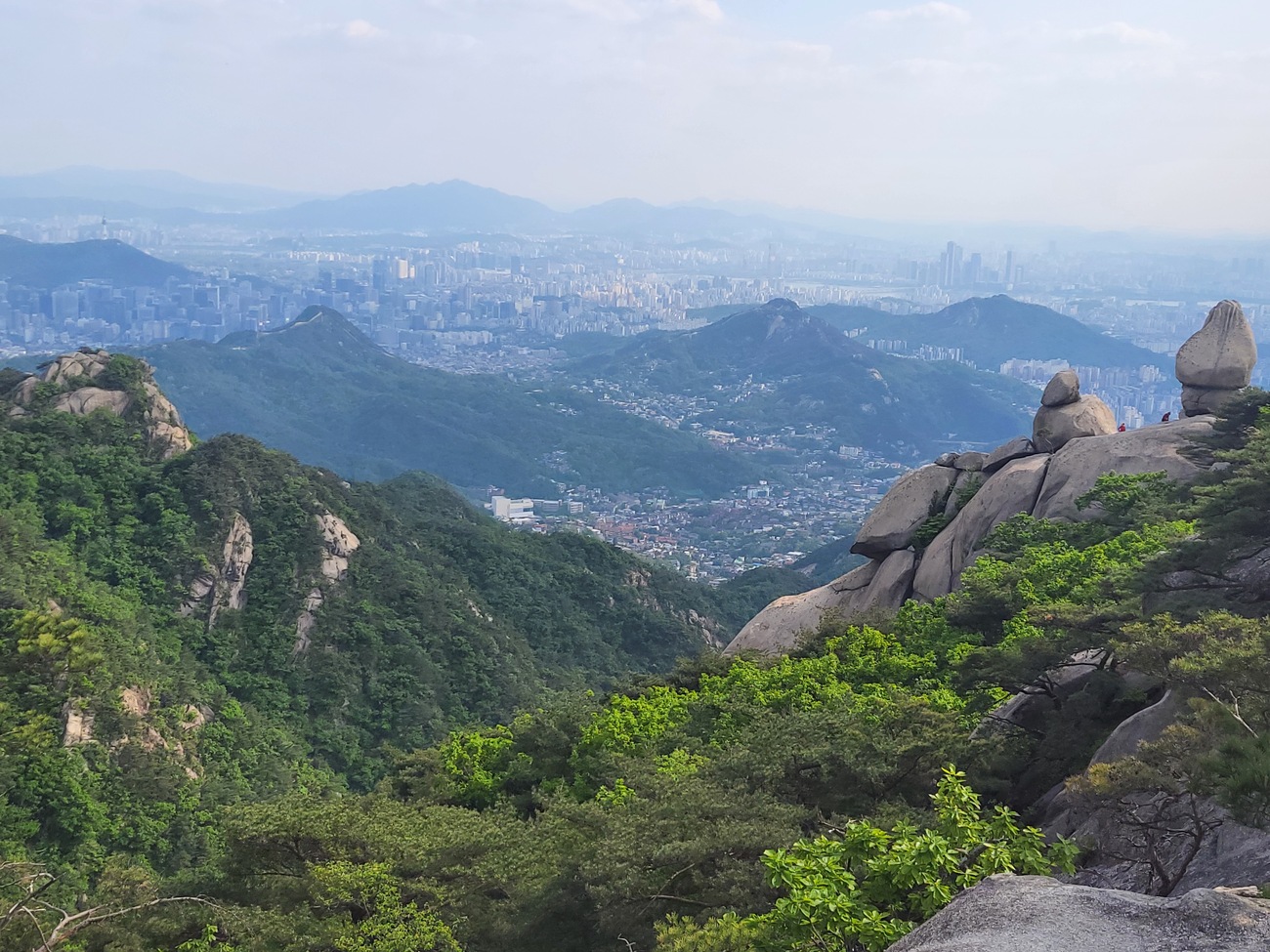
After two hours of steady hiking, we finally reached Munsubong Peak. At 727 meters above sea level, the view was breathtaking. The surrounding landscape, with its mix of rocky cliffs and lush greenery, stretched as far as the eye could see. Looking down, I could see the winding trails that led us here, and I couldn’t help but feel a sense of pride for making it to the top.
A Refreshing Break at the Summit
I was starving by the time we reached the peak, and although I had packed a portable stove to cook a hot meal, fire restrictions at the summit prevented us from using it. Instead, we settled for some instant ramen and hot water that we had brought along. As we enjoyed our simple meal, the cool breeze at the summit made the experience even more relaxing.

It was here that I met a fellow hiker from abroad, who was also admiring the view. We exchanged a few friendly words before taking turns snapping photos of each other with the scenic backdrop. Moments like these are what make hiking in Seoul so special—you never know who you’ll meet or what stories you’ll share along the way.
The Descent and Hidden Trails
After resting for about an hour, we decided to take the Bibong trail on our way down. The descent was steep and narrow in some areas, so we had to move carefully. Along the way, we stopped at Bibong Peak for a brief rest before continuing down the trail. As we walked, we discovered a small stream where we could cool off and fill our bottles with fresh mountain water. It wasn’t much, but after hours of hiking in the heat, it felt like heaven.
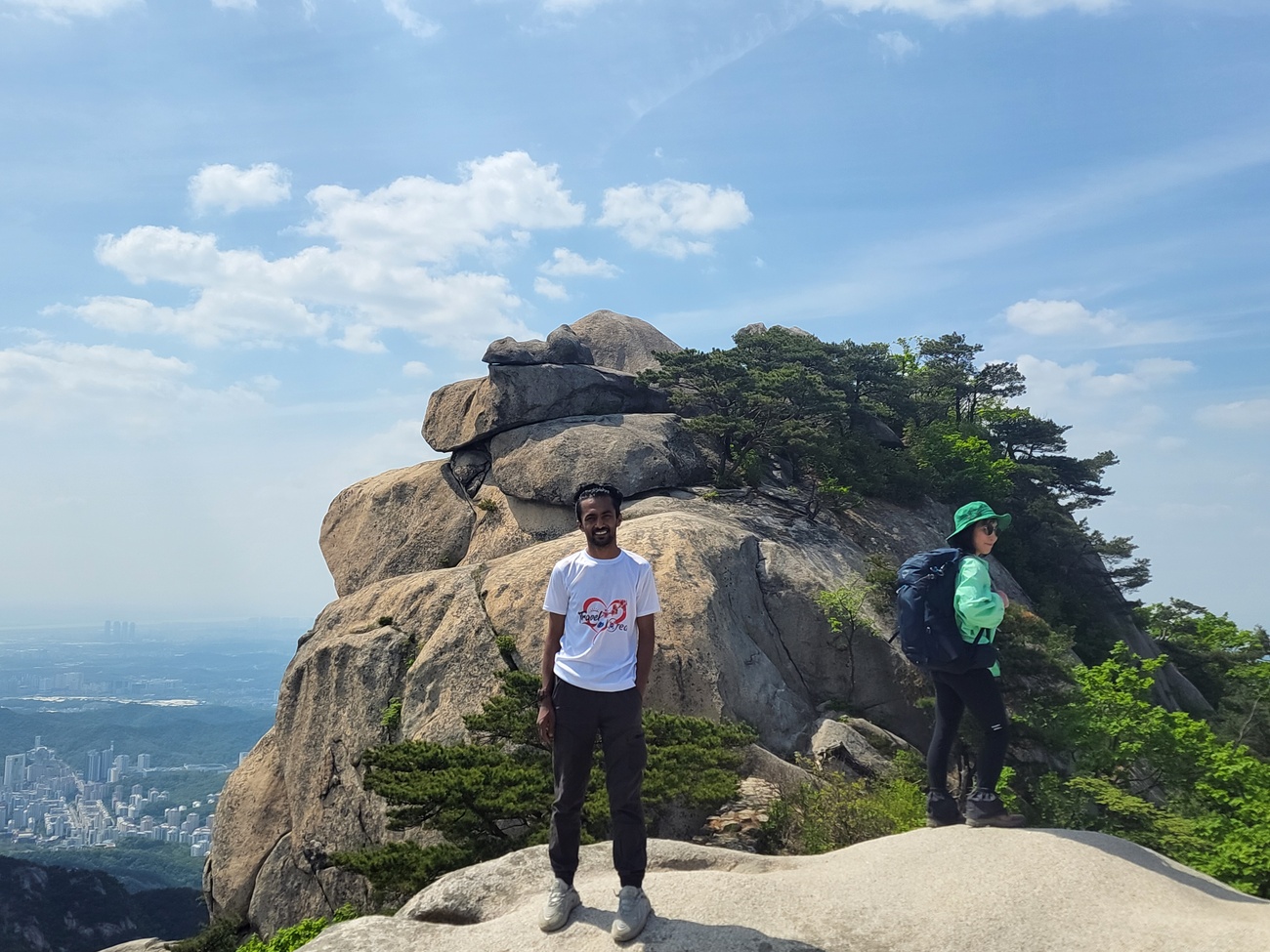
One of the highlights of descending Bukhansan National Park is meeting fellow hikers who are always eager to share snacks, water, and stories. This sense of community is one of the reasons I love hiking in Korea.
As we reached the bottom near Jingeoansa Temple, we were both exhausted but incredibly satisfied. We had hiked for hours, explored new trails, and taken in some of the most stunning views of Bukhansan Mountain.
Munsubong Peak Hiking Route Details
The trail to Munsubong Peak begins at the Daeseongmun Gate (대성문), which is easily accessible from the Bukhansan National Park entrance. Here’s a breakdown of the route:
- Daeseongmun Gate (대성문): This is the official starting point for the Munsubong trail. From the gate, the trail winds through dense forest with plenty of shade, making it a pleasant start to the hike.
- Daenammun Gate (대남문): After about 40 minutes of hiking, you’ll arrive at Daenammun, a key junction where you can take a brief rest. This area has benches and shaded spots, making it a good place to recharge before the steeper section of the trail begins.
- Left Turn Toward Munsubong: From Daenammun, take a left turn to follow the signs pointing toward Munsubong Peak. The path becomes rockier and more challenging, so take your time and watch your footing. You’ll pass small streams and rocky outcrops along the way.
- Final Ascent: The last section of the trail involves a moderately steep climb with some uneven terrain. Be cautious, especially during wet or icy conditions. The trail is well-marked, and after approximately two hours of hiking, you’ll reach the summit.
- Munsubong Peak Summit (문수봉): At 727 meters, Munsubong offers incredible views of Bukhansan National Park and the surrounding landscapes. The summit has a small open area where you can rest, take photos, and enjoy the breathtaking scenery.
- Descent via Bibong Trail (비봉길): For the way back, many hikers choose to descend using the Bibong Trail, which is slightly narrower and steeper but offers a scenic route with occasional streams and resting spots. The trail eventually leads back to the base near Jingeoansa Temple (진관사).
This route is ideal for hikers of all levels, though beginners should be cautious of the steep sections and slippery rocks. With proper preparation and pacing, Munsubong Peak can be a rewarding hike that leaves you with lasting memories of hiking in Seoul.
How to Get to Munsubong Peak at Bukhansan Mountain
Getting to Munsubong Peak in Bukhansan National Park is convenient and well-supported by public transportation from Seoul. The most popular and easiest way to access the trail is through Gupabal Station on Seoul Metro’s Line 3. Once you arrive at Gupabal Station, take Exit 1, where you’ll find several buses waiting to take hikers directly to the park entrance. The 7842 bus is a common choice, and within 15-20 minutes, you’ll arrive at the Bukhansan National Park entrance near Daeseongmun Gate (대성문).
If you prefer an alternative route, you can start from Gireum Station (Line 4). From there, hop on buses 110B or 143, which will take you to the Bukhansanseong Fortress area. This route is ideal if you plan on exploring multiple peaks or trails within the park. For those seeking a quieter trailhead, consider getting off at Jingwansa Temple (진관사), which connects to several scenic trails, including the one leading to Munsubong.
If you’re traveling on a weekend, it’s best to arrive early in the morning to avoid crowds. Buses can get quite packed with hikers, especially during peak hiking seasons. Don’t forget to check the bus schedules and plan accordingly, as they can vary depending on the time of day.
Best Time to Visit Munsubong Peak
The best time to visit Munsubong Peak depends on the type of scenery and weather you prefer. Spring (April to June) is a fantastic time when the trails come alive with blooming flowers and lush greenery. The temperature is pleasant, making it ideal for long hikes. Autumn (September to November) is another popular season, thanks to the stunning autumn foliage that transforms Bukhansan Mountain into a colorful landscape of red, orange, and yellow hues.
During the summer months (July to August), you can expect hot and humid weather, but early morning hikes can still be refreshing. However, be cautious of afternoon rain showers during the monsoon season. Winter (December to February) offers a completely different experience with snow-covered trails and crisp, clear air. While the views are breathtaking, make sure to dress warmly and wear proper hiking boots for icy terrain.
Other Peaks in Bukhansan National Park
Bukhansan National Park is home to several peaks, each offering unique views and challenges. Among the most popular is Baegundae Peak (백운대), the highest peak in the park at 836 meters. It’s known for its panoramic views of Seoul and its challenging yet rewarding trail, making it a favorite among experienced hikers. If you’re planning to explore more of Bukhansan, consider adding Baegundae Peak to your itinerary, as it’s a great way to experience the park’s diverse landscapes. For those interested in a longer adventure, many trails connect Munsubong to nearby peaks like Insubong (인수봉) and Bibong (비봉).
These interconnected trails make Bukhansan an ideal destination for both short hikes and full-day excursions. To learn more about hiking Baegundae Peak, check out our detailed guide on the route and difficulty.
